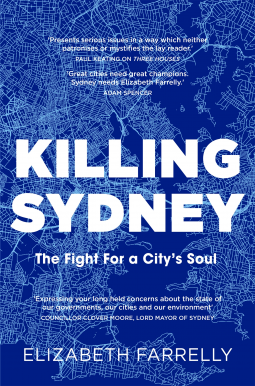
Killing Sydney
The Fight for a City's Soul
by Elizabeth Farrelly
This title was previously available on NetGalley and is now archived.
Send NetGalley books directly to your Kindle or Kindle app
1
To read on a Kindle or Kindle app, please add kindle@netgalley.com as an approved email address to receive files in your Amazon account. Click here for step-by-step instructions.
2
Also find your Kindle email address within your Amazon account, and enter it here.
Pub Date Jan 27 2021 | Archive Date Apr 26 2021
Pan Macmillan Australia | Picador Australia
Talking about this book? Use #KillingSydney #NetGalley. More hashtag tips!
Description
'Presents serious issues in a way which neither patronises or mystifies the lay reader.' Paul Keating on Three Houses
A blueprint for the future of our city in a radically changing world.
Columnist Elizabeth Farrelly brings her unique perspective as architectural writer and former city councillor to a burning question for our times: how will we live in the future? Can our communities survive pandemic, environmental disaster, overcrowding, government greed and big business?
Using her own adopted city of Sydney, she creates a roadmap for urban living and analyses the history of cities themselves to study why and how we live together, now and into the future.
Killing Sydney is part-lovesong, part-warning: little by little, our politics are becoming debased and our environment degraded. The tipping point is close. Can the home we love survive?
Praise for Killing Sydney
'If you believe that Elizabeth Farrelly is expressing your long held concerns about the state of our governmens, our cities and our environment in her Sydney Morning Herald Saturday articles, then I encourage you to get Killing Sydney and have a month of Saturdays in the one book. That's what I'll do because I most often strongly agree!' Councillor Clover Moore, Lord Mayor of Sydney
'This is an important book for all Aussies! Written with passion, beautiful prose, and insightful knowledge. Read and weep. More than ever we need to push pause on development and so called "progress". Go Elizabeth!' Di Morrissey AM
'Great cities need great champions. Sydney needs Elizabeth Farrelly.' Adam Spencer
Available Editions
| EDITION | Other Format |
| ISBN | 9781760552589 |
| PRICE | A$31.81 (AUD) |
Featured Reviews
‘Sydney’s not full. And it’s not failing because of density. It’s just fed up with too much development too fast and too close, development that is ugly, greedy, undercontrolled and importunate.’
I read this book because, while I have never lived in Sydney, I have spent quite a bit of time there both personally and professionally. I spent some time in the beautiful Education Department building in Bridge Street in the early 1980s (since sold by the NSW government) and in other buildings around the CBD. I have enjoyed walking around the inner city especially Surry Hills and Potts Point. But these days, my visits are occasional (for medical reasons or cultural purposes) and more often my rare trips terminate in what the real estate world now calls ‘Outer South Western Sydney’ (around Tahmoor and Picton).
Walking around the centre of Sydney or catching the train (during non-peak times) is enjoyable. Trying to drive around in Sydney or using public transport during peak times is horrific. To me, Sydney looks full. How can Sydney accommodate more people? This is the question I kept in my mind as I read Ms Farrelly’s book.
From reading this book (and from my own observations) too much of the development is driven by profit: short-term profit by government as public assets are exchanged for money; and longer-term profit by developers fitting as much income-generating activity into as little space as possible. And the people? For me, that is the heart of Ms Farrell’s message. Most of the development or redevelopment disregards what people want or need. Especially people on low incomes. And what about the people whose lives have been disrupted by WestConnex?
If cities are meant to be about and for people, then people’s views should be considered. Ms Farelly mentions the newDemocracy model. I was fortunate enough to be part of the group selected to look at Housing Choices in the ACT, and I think that the process followed there was a good example of citizen involvement. I am one of those people, Ms Farrelly, who lives in and likes Canberra. And Canberra has problems of its own: travel can be problematic for those without access to a car, especially in the more remote suburbs. But development in Sydney troubles me more. The endless urban sprawl, the impact (on the environment and on people’s health) of the commuting between home and work, the reclamation of public space for private development.
Ms Farrelly raises several important questions in this book If you have an interest in Sydney, if you care about cities meeting the needs of their inhabitants, then I recommend reading this book. The issues raised by Ms Farrelly apply to all large cities.
Note: My thanks to NetGalley and Pan Macmillan Australia for providing me with a free electronic copy of this book for review purposes.
Jennifer Cameron-Smith



